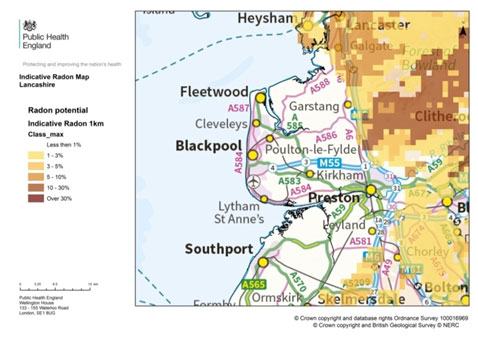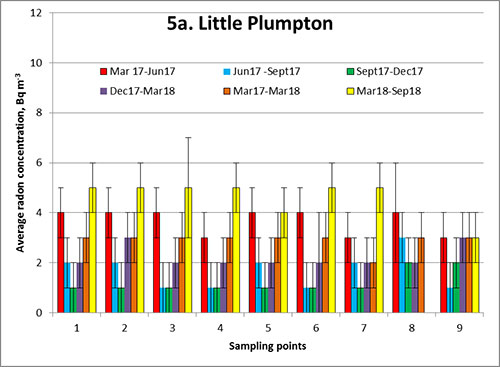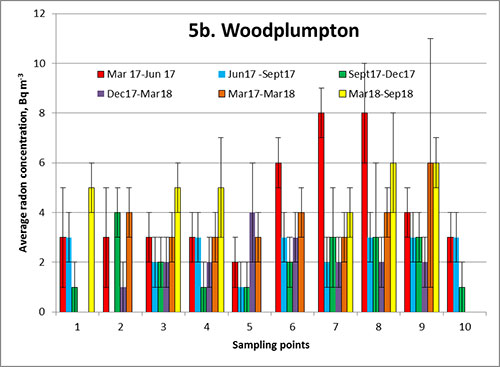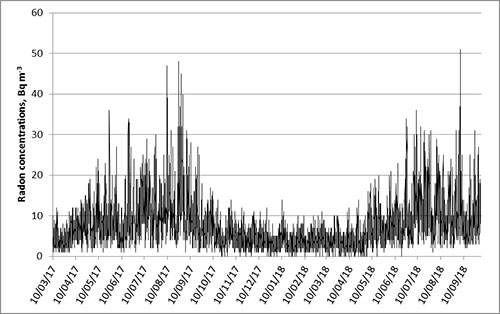Radon in air
Radon is a naturally occurring radioactive gas that is released from the ground and is present everywhere. Outdoor radon levels in the UK are low, typically a few Becquerels per cubic metre of air.
Indoor radon levels vary across the UK from less than ten to thousands of Becquerels per cubic metre of air. More information is available at www.UKradon.org.
The 2014 Public Health England (PHE) report (PHE-CRCE-009) on the potential public health impact of shale gas in the UK recognised that radon may be released to the environment from shale gas activities but at levels that are not expected to result in significant additional radon exposure. The report recommended the establishment of baseline radon levels in areas of interest for shale gas activities.
In this project Public Health England is monitoring the existing outdoor and indoor radon concentrations in the Fylde, Lancashire.
Radon Affected Areas are those where at least 1% of homes are expected to have high radon levels. The area of Fylde in Lancashire is not a radon Affected Area. This is illustrated in Figure 1.
Indoor radon monitoring
Results from the five 3–month periods (May 2017 to August 2018)
Three areas were selected for indoor radon monitoring in the Fylde:
- the area around Little Plumpton, (at about 2–3 km from the PNR extraction site)
- the area around Roseacre Wood
- the area around Woodplumpton – a control site
The control site was chosen to be situated within a similar distance of both the PNR site and Roseacre Wood site. In early April 2017 a total of 600 households were sent letters inviting them to take part in the indoor radon monitoring. There were 135 positive replies (23 % response rate). In early May 2017, detectors were sent to householders who had agreed to monitor radon in their homes. These were in the target areas around Little Plumpton, (51 houses), Roseacre Wood (47 houses) and Woodplumpton (37 houses).
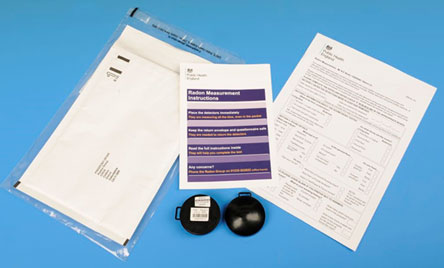
Each test consists of PHE’s standard pack of 2 passive detectors, shown in Figure 2, that are placed for 3 months in an occupied bedroom and living area. Indoor radon will be monitored over the length of this study in the selected houses. Each participant will receive several 3–month packs. In addition each home received detectors to carry out monitoring for a longer continuous period.
Results from the reported annual average radon concentrations estimated from the five 3–month back to back tests in homes were analyzed and are presented in Table 1. The annual average radon concentrations were calculated employing seasonal correction factors as outlined in the PHE Validation scheme (Howarth C B and Miles J C H, 2008). Distribution parameters were calculated for each area, assuming log–normality. The results for the homes around Little Plumpton, Roseacre Wood and Woodplumpton are consistent with the expected low radon potential for this area.
| Area(number of homes per period) | First 3–month results (May–Aug 17), Bq/m3 | Second 3–month results (Aug–Nov 17), Bq/m3 | Third 3–month results (Nov–Feb 18), Bq/m3 | ||||||
|---|---|---|---|---|---|---|---|---|---|
| Range | GM | GSD | Range | GM | GSD | Range | GM | GSD | |
| Little Plumpton (36/36/40) | 6-90 | 33 | 1.9 | 4-100 | 29 | 2.1 | 1-50 | 14 | 2.5 |
| Roseacre Wood (34/33/33) | 8-90 | 25 | 1.7 | 7-70 | 23 | 1.7 | 2-40 | 13 | 1.8 |
| Woodplumpton (40/36/32) | 10-80 | 26 | 1.7 | 8-80 | 21 | 1.8 | 4-60 | 11 | 1.7 |
GM = Geometric Mean
GSD = Geometric Standard Deviation
| Area(number of homes per period) | Fourth 3–month results (Feb–May 18), Bq/m3 | Fifth 3–month results (May–Aug 18), Bq/m3 | ||||
|---|---|---|---|---|---|---|
| Range | GM | GSD | Range | GM | GSD | |
| Little Plumpton (36/40) | 2-60 | 16 | 2.0 | 2-90 | 25 | 2.1 |
| Roseacre Wood (31/31) | 5-30 | 12 | 1.7 | 6-100 | 23 | 1.9 |
| Woodplumpton (36/39) | 5-40 | 11 | 1.7 | 5-60 | 20 | 1.7 |
GM = Geometric Mean
GSD = Geometric Standard Deviation
Outdoor radon monitoring
This part of the project will establish the baseline level of radon in outdoor air. Two areas have been selected for outdoor radon monitoring in the Fylde:
- The area around Little Plumpton at about 2 km from the Preston New Road (PNR) site - 9 sampling points
- The area around Woodplumpton at about 10 km from the PNR site, control site - 10 sampling points
Passive radon monitors, very similar to those used routinely in homes, have been placed in small aluminium wrapped plastic pots in discreet but open-air locations for 3 months or longer. The outdoor radon monitoring pack and placement of detectors are shown in Figure 3 and Figure 4.
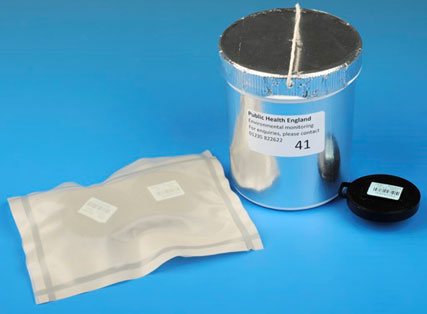
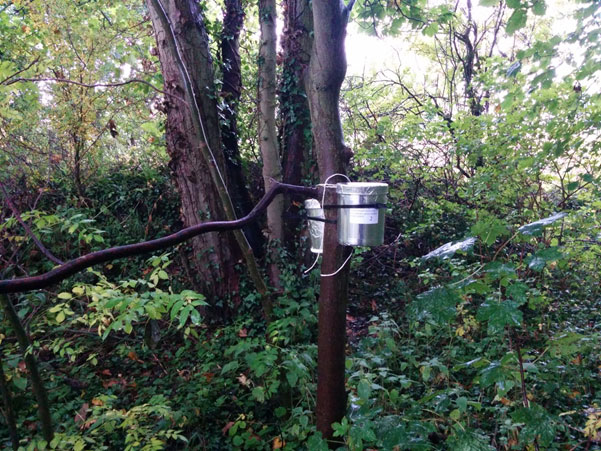
Results from the monitoring (March 2017 to September 2018)
The aluminium-wrapped plastic pots placed at each sampling point initially contained four 3-month and four 1-year passive detectors to record radon concentration. The detectors were replaced and processed following the standard procedures during the monitoring period. Some of the sites around Woodplumpton were vandalized, with pots or detectors missing. For these sites no data were reported for some of the periods.
Aggregated results for outdoor monitoring from the four 3-month measurement and one 6-month period including the 1-year test are given in Table 2. The analysis of the detectors for the above periods indicates that the average radon levels were similar around the Little Plumpton area and the Woodplumpton area.
| Area | First 3–month (Mar–June 17) Bq/m3 | Second 3–month (Jun–Sept 17) Bq/m3 | Third 3–month (Sept–Dec 17) Bq/m3 | Fourth 3–month (Dec 17–Mar 18) Bq/m3 | 1 year (Mar 17–Mar 18) Bq/m3 | 6 month (Mar–Sep 18) Bq/m3 |
|---|---|---|---|---|---|---|
| Little Plumpton | 4±1 | 2±1 | 1±1 | 2±1 | 3±1 | 5±1 |
| Woodplumpton | 4±1 | 3±1 | 2±1 | 2±1 | 4±2 | 5±1 |
The above results are similar to those measured in previous studies (Wrixon et al 1988). The results for the 3-month for both areas show low radon levels and are close to the detection limit for the passive radon detection technique.
The estimated average radon concentrations at each sampling point in the areas around Little Plumpton and Woodplumpton are presented in Figures 5a and 5b.
Monitoring near the Preston New Road site
Measurements of radon in outdoor air were made close to the PNR site. Continuous measurements were made using an active monitor (AlphaGUARD). The data from the AlphaGUARD, for period March 2017 – September 2018 were analysed. The inherent background of the instrument of 2 Bq m-3, resulting from the longer half–life alpha emitting radionuclides, was taken into account when data were processed. The radon data, taken at 1 hour intervals, are log-normally distributed. The distribution parameters for the five monitoring periods are given in Table 3. The first four monitoring periods were 3 months while the fifth period was 6 months. The average radon concentrations measured over the five monitoring periods were in the range 2 to 9 Bq m-3.
Passive monitors were also placed at the same location. The average radon concentrations measured using 10 passive detectors are similar to the arithmetic means (AM) of the distributions measured with the AlphaGUARD for these periods as shown in Table 3.
| AlphaGUARD | Passive detectors | |||||
|---|---|---|---|---|---|---|
| Period of monitoring | Bq/m3 | Bq/m3 | ||||
| Range | Arithmetic Mean (AM) | Geometric Mean (GM) | Geometric Standard Deviation (GSD) | Arithmetic Mean (AM) | Standard Deviation (SD) | |
| March 17 – June 17 | 1–35 | 6 | 5 | 1.9 | 7 | 2 |
| June 17 – Sept 17 | 1–46 | 9 | 7 | 2.0 | 10 | 1 |
| Sept 17 – Dec 17 | 1–12 | 3 | 3 | 1.8 | 4 | 1 |
| Dec 17 – March 18 | 1–12 | 2 | 2 | 1.8 | 2 | 1 |
| March 18 – Sept 18 | 1–49 | 6 | 5 | 2.2 | 4 | 1 |
Time series of the measured radon without background correction are given in Figure 6. The results show that there are variations in the hourly concentrations measured at the site, however the overall average radon concentrations agrees well with the results of the passive detectors from the same location.
Summary
The results for both the outdoor and indoor radon monitoring show low radon concentrations that are consistent with the anticipated radon levels in this area.
References
Howarth, C B, and Miles, J C H. 2008. Validation scheme for organisations making measurements of radon in dwellings: 2008 revision. Chilton, HPA–RPD–047.
Miles, J C H, and Algar, R A. 1988. Variations in radon–222 concentrations. Journal of Radiological Protection 8 (2), 103–106.
Kibble, A, Cabianca, T, Daraktchieva, Z, Gooding, T, Smithard, J, Kowalczyk, G, McColl, N P, Singh, M, Mitchem, L, Lamb, P, Vardoulakis, S, and Kamanyire, R. 2014. Review of the Potential Public Health Impacts of Exposures to Chemical and Radioactive Pollutants as a Result of the Shale Gas Extraction Process, Chilton, PHE–CRCE–009.
Wrixon, A D, Green, B M R, Lomas, P R, Miles, J C H, Cliff, K D, Francis, E A, Driscoll, C M H, James, A C, and O’Riordan, M C. 1988. Natural Radiation Exposure in UK Dwellings. Chilton, NRPB–R190.
Contact
Contact BGS enquiries for further information.

